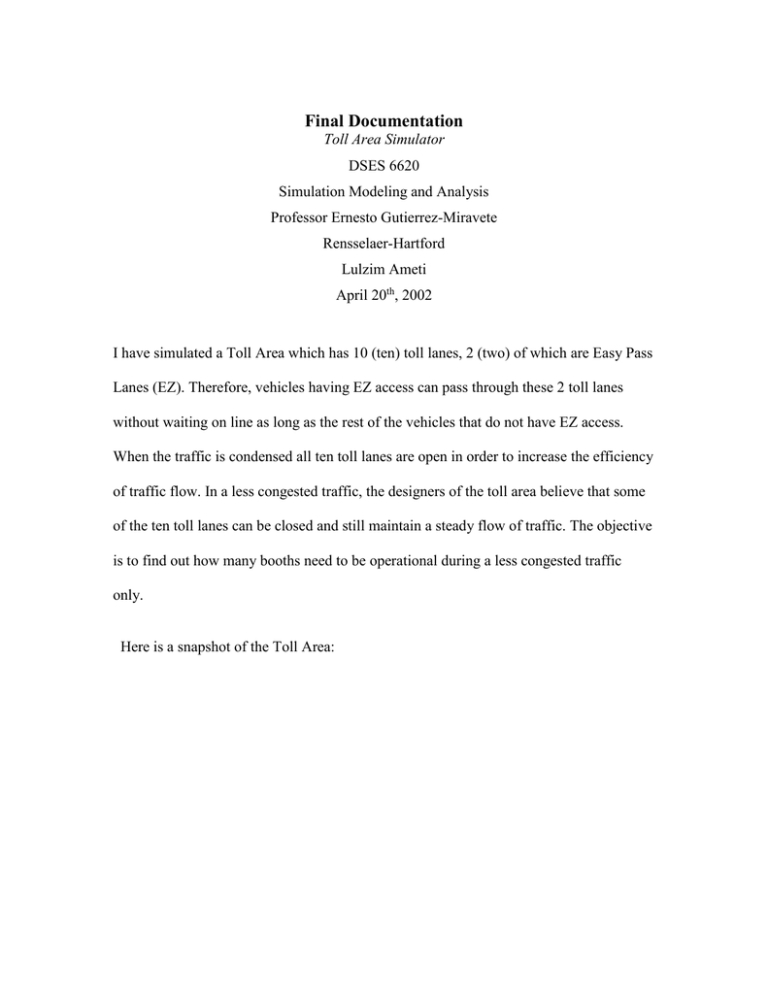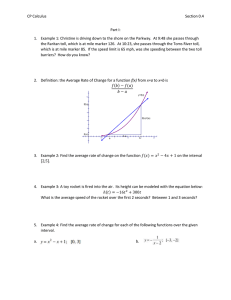Final Documentation
advertisement

Final Documentation Toll Area Simulator DSES 6620 Simulation Modeling and Analysis Professor Ernesto Gutierrez-Miravete Rensselaer-Hartford Lulzim Ameti April 20th, 2002 I have simulated a Toll Area which has 10 (ten) toll lanes, 2 (two) of which are Easy Pass Lanes (EZ). Therefore, vehicles having EZ access can pass through these 2 toll lanes without waiting on line as long as the rest of the vehicles that do not have EZ access. When the traffic is condensed all ten toll lanes are open in order to increase the efficiency of traffic flow. In a less congested traffic, the designers of the toll area believe that some of the ten toll lanes can be closed and still maintain a steady flow of traffic. The objective is to find out how many booths need to be operational during a less congested traffic only. Here is a snapshot of the Toll Area: As stated in the proposal there are few conditions that have to be met: -waiting time of no longer than 30 seconds on average. -have to be cost efficient. Another specification about this system is that each lane can hold 15 vehicles only. That is the distance between the toll booth itself to the area where the road diverges. Therefore, there should be enough booths open so lanes are no more than 15 vehicles in length. The EZ Pass lanes on the other hand have capacity to accommodate 30 vehicles each. Data Collection: The only real data I have here is the Service Time. While working on this project I had the opportunity to go through a toll area about 20 times. Five times I had the exact change and the service time it was only a second or two seconds. For the rest of the times when I had to wait to get the change back the service time was between 10 and 15 seconds. Therefore I have chosen for my model the Service time to be on average six (6) seconds with standard deviation of 1 second. Other real data is the capacity of EZ Pass lanes, which was available on the Internet. The Speed at which you drive through a designated EZ Pass Lane is posted at each toll lane. The throughput is 2,000 vehicles per hour per lane or 33 vehicles per minute per lane. Electronic Toll Collections systems are a key component of intelligent transportation services that are being utilized by transportation authorities to make traveling safer and more efficient. The EZ Pass Lane consists of three inter-related subsystems that are linked via a fiberoptic communications network to the FAST LANE Service Center. The three subsystems are: automatic vehicle identification, automatic vehicle classification and violation enforcement. For the arrivals of vehicles at this Toll Area I tried to make reasonable assumptions. One hundred and four (104) vehicles are arriving each minute with a standard deviation of 0.1 minute. To implement the desired simulation I did the following steps: I built the module. Ran it having one booth open. The objective wasn’t met. Continued to add booths one by one until I got to the desired results. I came to conclusion that only 8 booths need to be open in order to meet all the above mentioned requirements. The Toll Area at this point looks like this: After running the simulation model, statistics show that average time spent in the system is just below 20 seconds. There was an average of 4 vehicles per queue. The longest queue at certain times reaches 14 vehicles, which is just good enough to meet the system specification. At this point I should mention that this person being the 14th in line will have to wait approximately a minute and half to get though the system. Achieved being cost efficient by being able to close down two toll booths. In final words, all three objectives were met: waiting time less than 30 sec on average, not having a queue which length is longer then 15 vehicles and at the same time being cost efficient. The model was verified and validated by tracing the simulation at runtime. It was doing what was expected to do.
